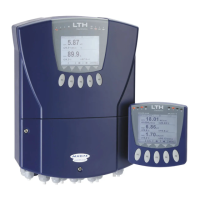Channel Setup
MXD70 Suspended Solids / Turbidity
Setup and Operating Guide
- 7 -
Channel Setup
Installation and Choice of Suspended Solids /
Turbidity Sensors
Quadbeam Sensors incorporate engineering improvements to eliminate water ingress and also
withstand the rapid temperature cycling (from 10C to 80C) which occurs during CIP cleaning cycles.
By design, Quadbeam
TM
sensors automatically compensate for component ageing, sensor fouling and
daylight interference.
The Quadbeam
alternating light principle is based on a fundamental method of suspended solids
measurement by shining a light of known intensity a fixed distance through a medium at a photocell
detector. Suspended solids in the medium attenuate some of the light. The detector current gives a
measure of the attenuation that corresponds to the suspended solids and turbidity measurement.
The Quadbeam
alternating light principle compensates for variations in light intensity and detector
sensitivity and detector sensitivity by using two detectors and two light sources switched on and off
alternatively. The resulting probe signal can then be converted to appropriate engineering units by
using the instruments linearisation curve (see page 14).
However some factors are far too complicated to be modelled or compensated for (e.g. bubbles,
refraction effects due to elevated temperatures etc.) and must be minimised at the monitoring point.
The sensors are available with different sensitivity levels and measuring ranges by changing the
distances between the light sources and detectors. Sensors with shorter path lengths can measure
higher concentrations and have larger measuring ranges where as sensors with longer path lengths
are more sensitive to small changes in suspended solids concentration.
S Series Suspended Solids Sensors
The S Series of suspended solids sensors are available as immersion or hygienic style sensors and both
are capable of operating in temperatures up to 85C.
The immersion sensors are designed for continuous on-line monitoring of suspended solids in
industrial and municipal water and waste water treatment plants, mining and refining operations.
Applications include: Effluent monitoring in clarifier overflow weirs, Final effluent monitoring, Mixed
liquor suspended solids, Product loss in milk processing plants, Return activated sludge, Sludge
blanket detection, White water solids concentration.
The hygienic style sensors are designed for installation directly into food product lines where CIP
cleaning is used. The one piece Polypropylene construction with a surface finish of better than 0.9m
Ra eliminates bacteria traps. The sensors have an industry standard triclover connection.
Applications include: Milk fat measurement in the dairy industry, Percentage solids measurement in
fruit and vegetable juices, Product breakthrough on plate heat exchanges, Solids content in whey.
High temperature immersion and hygienic versions of the S series of suspended solids sensors are
available. These sensors are manufactured from PVDF with a maximum working temperature of 105C.
T Series Turbidity Sensors
The T series of sensors are a new generation of Quadbeam turbidity process sensors, which combine
both light attenuation and 90 degree scattered light measurements in a ratiometric sensor with digital
communication. This technique vastly increases the sensitivity compared to sensors using just light
attenuation. The T series of sensors are designed to meet the international standards for turbidity
measurement – ISO 27027 and are capable of operating in temperatures up to 80C.
Applications include: Monitoring of clarifier overflow weirs, Final outlet of effluent from DAF plants,
Raw water inlet measurements in water treatment plants, Surface water monitoring, Solids loading in
rivers and streams, Product breakthrough on plate heat exchangers, Percentage solids in fruit and
vegetable juices.

